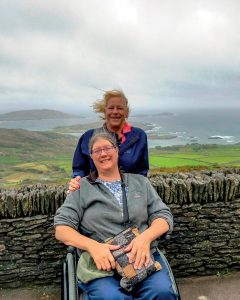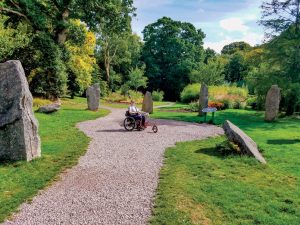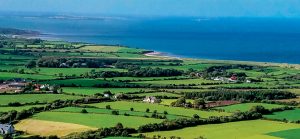Enchanting scenery, friendly people and fascinating history are all part of an accessible Ireland adventure
By Lilly Longshore
As I roll off the train in Belfast, Ireland, a man with strawberry-blonde hair and sparkling blue eyes asks me, “Do ya need help, m’ love?”
My duffle bag on my lap has gained weight since I left the U.S. I consider his offer for a few seconds and say, “Sure, thanks.” I let him lift the heavy bag from me.
My plan for this 10-day wheelchair-accessible journey is to visit a little of Northern Ireland for my friend Diane Johnson to research her ancestry, then head south to places I want to check out in the Republic of Ireland. Carrickfergus is our first destination.
We hire a cab owner, who spends the day with us. I transfer into the front passenger seat (driver’s side in the U.S.), and he fits my manual chair in the trunk with ease. He takes us around to Diane’s requested cemetery and homestead stops, including a visit with a “wee” woman who knows history about Diane’s ancestors.

Before we meet her, I ask our driver if “wee” means she is tiny. “No,” he says, puzzled that I would ask. “It’s just a [softer] expression,” — one widely used across the Emerald Isle, I note, especially in the north.
From inside the taxi, he points out tourist spots along the way, such as the filming location for the TV series Game of Thrones, which is blocked off for most, but our driver knows how to access the back side for a view.
At the end of the day, our driver takes us back to Belfast, where we stay at the Hampton Inn on Hope Street, one of the most thoughtfully designed accessible hotels in which I’ve ever stayed. The lobby and restaurant are roomy and easy to navigate. The room is spacious, and there are three sets of grab bars in the shower, an attached bench and more grab bars by the toilet in the large bathroom.
History In Belfast
Sightseeing in Belfast is easy wheeling because of flat streets and plazas and plenty of curb cuts. I use my FreeWheel wheelchair attachment throughout my stay, so cobblestone is nearly unnoticeable to me. Many cafés, shops and historic buildings, including Belfast City Hall and Belfast Castle, are accessible to manual chair users only (no scooters allowed) by way of level entrances or ramps and indoor elevators.
My highlight was the private 90-minute tour of The Troubles, a series of murals and walls depicting the violent struggles between Catholic/nationalists and Protestant/loyalists that erupted in 1969, with a driver from Black Cab Taxi.
Dozens of bold, colorful murals painted on buildings and walls throughout Belfast depict political heroes, symbols and slogans of The Troubles. It has mostly settled down since the 1998 signing of the Good Friday Agreement, but emotions are still easily stirred in some neighborhoods.
It is mostly a drive around town with some opportunities to get out and wheel around at spots where parking is easy.
I’m shocked to see the 20-foot, concrete and steel “peace wall” towering beside Falls Road and Shankill Road, separating the Catholics from their Protestant neighbors. There are still more than 100 peace walls erected throughout Northern Ireland. Coated with paintings of various freedom fighters such as Nelson Mandela and Martin Luther King Jr., and signatures from the Dalai Lama and former U.S. President Bill Clinton, the Falls Road wall trails off into the foothills as far as I can see.
Our driver tells us the wall gates are now open every day except for one day of the year, Remembrance Day. He, along with his wife and son, nearly died in a bombing that destroyed their car back in the 1990s. Decades later, the impact of this trauma still surfaces.
He shakes off the memories as he tells us, “Life is much more peaceful and safer here nowadays.”
But the peace walls remain, serving both as a peacekeeper and as a canvas for people to reveal their thoughts and feelings.
Hitting The Books
We hop the Enterprise train back to Dublin. Each train ride in Ireland is made wheelchair-accessible by railway workers, who bring ramps to help me enter and exit the train.
We stay at the Academy Inn on O’Connell Street, which is a happening area of town and a great choice for us — the place is full of pubs, shops and open-market booths.
We tour Trinity College, established in 1592 by Queen Elizabeth I, and a student gives us a wonderfully informative guided tour of campus. I easily roll on cobblestone surfaces with my FreeWheel, and the walkways and plazas are wide and mostly flat.
“This is a statue of George Salmon, former provost of Trinity College,” says our tour guide, pointing out the marble sculpture of a stoic man seated on a chair at the center of campus. “He once said, ‘Over my dead body will women enter this college.’” She pauses, “Well, he certainly called it. If you wait a bit after commencement ceremonies, you’ll see female graduates that make their way over here to get their photos taken draped across his lap.” With a confident nod she adds, “Over his dead body, they did get their degrees.”
She tells us about the days when Catholics were banned by the church from attending Trinity College to prevent fraternization with the Protestants. This contentious theme seems to pop up more than I expected during my visit.
The Book of Kells, a lavishly illustrated copy of the four Gospels of the New Testament written in Latin, and the truly beautiful, prestigious library of exclusively leather-bound books is extraordinary. Wheeling up the entrance ramp is easy, and inside there is an elevator to get from floor to floor.
Our tour guide asks us to guess how the books in the library are organized. After a few guesses, she tells us they are organized by weight.
“I don’t know about you, but I never know how much a book I want to read weighs,” she says.
A Castle, A Ring & A Peninsula
A comfortable Irish Rail train takes us from Dublin a few hours south to Cork, our next destination.
Cork is a lively city, rich with street musicians in the plazas. We stop by the English Market, where fresh fruits, vegetables and meats of all kinds are showcased. It’s a flat entrance into the single-story market. The air is heavy with the smell of fresh seafood. We find a few artisan shops, and down the level cobblestone walkway, Carrolls Irish Gifts is a gold mine for selecting Irish souvenirs for my whole family.
A short taxi ride from downtown Cork gets us to the Blarney Castle. The castle itself is not wheelchair-friendly, but the gardens that ramble on forever are fabulous.

From the gardens, the view of the famous castle perched on a hill is excellent. The trails are a combination of cobblestone, concrete and packed dirt and are easy to wheel with my FreeWheel.
In the Bog Garden, I pass by waterfalls and many metal sculptures — a horse’s head in a pond, a fox in the weeds and a lizard climbing up a rock. The damp, earthy smell, along with the presence of ancient yew trees and bamboo thickets fill me with a sense of authentic Celtic peace.
Another hour-and 20-minute train ride south takes us to Killarney, the perfect location from which to explore both County Kerry and the Dingle Peninsula.
In Killarney, we stay at Neptune Hostel in a clean, accessible room. It works well for me, with a spacious bedroom and private bath. The bed is a bit low for me but doable. There are grab bars by the toilet but none in the shower. I ask for a solid chair that I use as a transfer bench.
Staying at the hostel allows me to save money that I then spend on Deros bus tours of both the Ring of Kerry and the Dingle Peninsula.
The all-day Ring of Kerry tour takes us past Killarney National Park, through the MacGillycuddy’s Reeks mountain range, past bays and islands and a monastery.
We stop in the nicely accessible towns of Glenbeigh, Waterville and Sneem for breaks and shopping.
The shops, restaurants and streets on this tour have ramps or level entries, curb cuts and flat walkways. I’m able to get to the first seat inside the short tour bus, and Deros drivers stow my manual chair below.
We drive by a famine town, through incredible green rolling hills spotted with sheep in fields sectioned off by hedgerows. The scenery is like nothing I’ve ever seen.
My favorite stop is at Kells Sheep Centre for a sheepdog demonstration. The shepherd’s different pitches and patterns of whistles command the dogs to clip out two sheep at a time from the herd at the top of the hill and bring them down to him. The eagerness and skill that the dogs display is impressive.
The following day on the Deros Dingle Peninsula tour, I wheel out on the beach and take many photos of the picturesque coast. This tour has fewer stops that are accessible to me, but the scenery from the bus is spectacular. We stop by a stone famine hut, which I can see but can’t get to because it’s up a narrow path on top of a steep hill. In the town of Dingle, I spend time getting “donkey kisses” from a friendly donkey named Macanta by feeding her long carrots from between my teeth.
Sing Along
On the way back to Killarney, our bus driver leads us all in singing “Molly Malone.” The whole bus joins in. I somehow know all the words to the chorus, dredged up from some childhood coffer. I love how the Irish spontaneously break into song — in taxis, trains and buses. It is delightful, and if you can sort of carry a tune, that’s good enough to sing along.
The Emerald Isle is full of surprises and history I never knew. The Irish people, who have endured their share of oppression and strife, rise above it all. They are quick to play, joke and break out in song.
With all of the spirited energy and natural beauty in the Emerald Isle, I think this “love” will be coming back for another “wee” visit.


